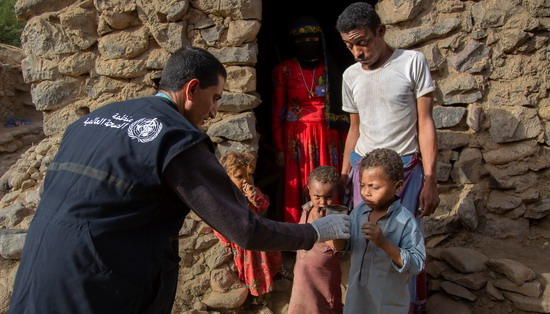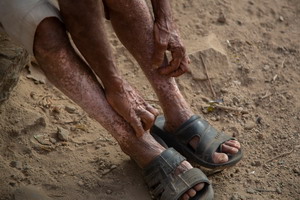 12 February 2019 | Geneva | Cairo | Sanaʽa – Defying logistical challenges and despite ongoing civil unrest and instability, health-care workers in Yemen have been able to distribute medicines through large-scale treatment of people at risk of onchocerciasis in 33 districts of the country’s 8 governorates [1].
12 February 2019 | Geneva | Cairo | Sanaʽa – Defying logistical challenges and despite ongoing civil unrest and instability, health-care workers in Yemen have been able to distribute medicines through large-scale treatment of people at risk of onchocerciasis in 33 districts of the country’s 8 governorates [1].
The 3-day campaign on 28–31 January 2019 was led by Yemen’s Ministry of Health, the World Health Organization’s country office, with support of the Expanded Special Project for Neglected Tropical Disease (ESPEN) and the World Bank through the Emergency Health and Nutrition Project (EHNP).
“We mobilized 970 teams led by 225 team leaders and more than 1935 health workers to assist in the distribution of ivermectin tablets,” said the National Director of Neglected Tropical Diseases Programme, Yemen. “Preparatory works started in December last year and training workshops were decisive in achieving maximum compliance during the campaign.”
Out of a total of 528 420 people targeted in all 8 governorates, 474 027 people were reached and treated, representing 90% coverage.
A total of 1 177 524 ivermectin tablets from the Mectizan Donation Programme were used during this latest campaign.
Onchocerciasis in Yemen
Unlike Africa, Yemen there are no records of eye complications or blindness due to onchocerciasis.
 The disease mainly manifests in a localized form, mainly in lower legs in the form of ‘onchodermatisis’ also known as ‘reactive onchodermatitis’. Intense itching and skin irritation associated with severe manifestations leads to skin abrasion and other dermal infections.
The disease mainly manifests in a localized form, mainly in lower legs in the form of ‘onchodermatisis’ also known as ‘reactive onchodermatitis’. Intense itching and skin irritation associated with severe manifestations leads to skin abrasion and other dermal infections.
The disease (locally known as ‘Sowda’ or ‘Sowdah’ referring to black pigementation) is endemic in 33 districts of the 8 governorates posing a risk to a total population of 3 million people.
Prevalence of onchocerciasis in Yemen is confined to the valleys running west of the Red Sea with over 60% clinical cases in the worst affected valleys. These areas abound with rapidly flowing water during the country's rainy seasons (usually between April and September) prompting fly breeding to take place. In Yemen, the vector for O.Volvulus is the blackfly, S. rasyani.
Prospects for elimination
Although Yemen started its onchocerciasis and lymphatic filariasis control programme as part of the National Leprosy Programme in 1992, targeting all people at risk of carrying microfilariae and susceptible to maintaining transmission even at a low level. The disease is under control and the national target is to achieve elimination as a public health issue as outlined in WHO’s Regional Office for the Eastern Mediterranean’s roadmap.
It is thanks to the technical support provided by the Regional Office and the dedicated work of local health workers and volunteers that treatment campaigns targeting everyone at risk are being sustained.
[1] Sana’a, Hajja, Ibb, Al-Mahweet, Dhamar, Raimah, Al-Hudaydah and Taiz


